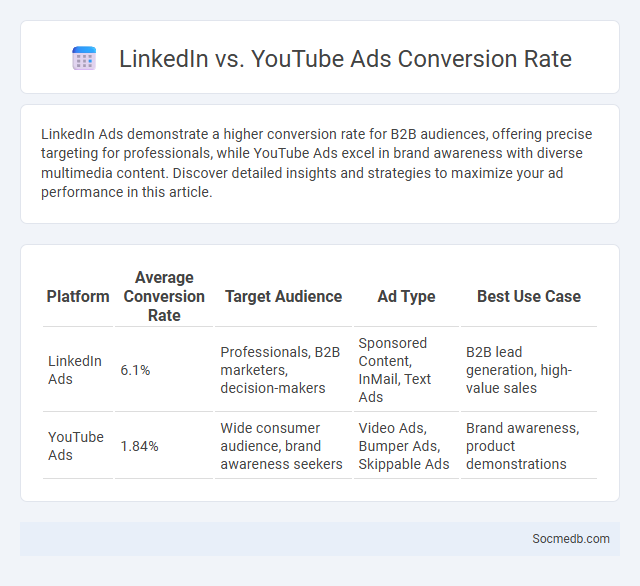
Photo illustration: LinkedIn vs YouTube Ads Conversion Rate
LinkedIn Ads demonstrate a higher conversion rate for B2B audiences, offering precise targeting for professionals, while YouTube Ads excel in brand awareness with diverse multimedia content. Discover detailed insights and strategies to maximize your ad performance in this article.
Table of Comparison
| Platform | Average Conversion Rate | Target Audience | Ad Type | Best Use Case |
|---|---|---|---|---|
| LinkedIn Ads | 6.1% | Professionals, B2B marketers, decision-makers | Sponsored Content, InMail, Text Ads | B2B lead generation, high-value sales |
| YouTube Ads | 1.84% | Wide consumer audience, brand awareness seekers | Video Ads, Bumper Ads, Skippable Ads | Brand awareness, product demonstrations |
Overview of LinkedIn and YouTube Ad Platforms
LinkedIn Ads provide a robust platform for B2B marketing, leveraging precise targeting based on job titles, industries, and professional interests to reach decision-makers effectively. YouTube Ads offer vast reach with diverse ad formats including skippable, non-skippable, and bumper ads, ideal for brand awareness and video engagement. You can maximize your campaign's impact by combining LinkedIn's professional targeting with YouTube's extensive audience and rich media capabilities.
Understanding Conversion Rate in Digital Advertising
Conversion rate in digital advertising measures the percentage of users who complete a desired action, such as making a purchase or signing up for a newsletter, after interacting with social media ads. Tracking this metric through platforms like Facebook Ads Manager or Google Analytics provides crucial insights into campaign effectiveness and audience engagement. Optimizing conversion rates involves analyzing user behavior, adjusting ad targeting, and refining ad creatives to align with specific marketing goals.
LinkedIn Ads Conversion Rate Benchmarks
LinkedIn Ads Conversion Rate Benchmarks vary across industries, with an average conversion rate ranging from 6% to 10%, reflecting the platform's professional targeting capabilities. B2B campaigns typically experience higher engagement rates due to LinkedIn's precise audience segmentation, which enhances lead quality and ROI. Understanding these benchmarks can help you optimize your LinkedIn Ads strategy to improve your campaign performance and maximize conversions.
YouTube Ads Conversion Rate Trends
YouTube ads conversion rates have steadily increased, driven by improved targeting algorithms and video content personalization. Marketers report an average conversion rate growth of 15% year-over-year, with video ads outperforming traditional display ads in user engagement and click-through rates. Data indicates mobile users contribute significantly to this trend, as mobile-driven conversions account for over 70% of total YouTube ad success.
Key Differences: Audience Targeting on LinkedIn vs YouTube
LinkedIn specializes in professional audience targeting, allowing you to reach decision-makers, industry experts, and B2B clients using precise criteria like job title, company size, and industry. YouTube targets a broader consumer base with interest and behavior-based algorithms that optimize content delivery through video engagement metrics. Understanding these distinctions ensures your marketing strategy effectively connects with your desired audience on each platform.
Factors Affecting Conversion Rates on LinkedIn
Conversion rates on LinkedIn are significantly influenced by the quality of content, targeting precision, and user engagement metrics. Tailoring posts with clear calls-to-action and leveraging LinkedIn's advanced targeting options, such as job title, industry, and company size, enhances lead generation effectiveness. Optimizing profile completeness and utilizing LinkedIn analytics to track user interaction further drive higher conversion outcomes.
Factors Impacting Conversion Rates on YouTube
Video quality and content relevance play crucial roles in enhancing conversion rates on YouTube by ensuring viewers remain engaged and motivated to act. Effective call-to-action (CTA) placements within videos, along with optimized video descriptions and metadata, significantly improve visibility and drive targeted traffic. Audience targeting through precise demographic and interest-based filters enables creators to reach users more likely to convert, boosting overall campaign performance.
Cost-Effectiveness: LinkedIn vs YouTube Ads Conversion
LinkedIn ads deliver highly targeted B2B leads with a cost-per-conversion averaging $60 to $80, making them efficient for reaching professionals and decision-makers. YouTube ads offer broader audience engagement with a lower cost-per-conversion of around $30 to $50, ideal for brand awareness and product demonstrations. Evaluating your campaign goals helps determine whether LinkedIn's precise targeting or YouTube's wide reach provides the best cost-effectiveness for your advertising budget.
Best Practices to Improve Conversion Rates on Both Platforms
Optimizing social media conversion rates requires tailored content strategies that align with platform-specific user behavior, such as leveraging Instagram's visual storytelling through high-quality images and shoppable posts while using Facebook's detailed audience targeting and retargeting ads to capture potential customers. Incorporating clear calls-to-action (CTAs), engaging video content, and social proof like reviews and testimonials can enhance user trust and drive sales on both platforms. Consistent performance analysis using analytics tools helps refine campaigns by identifying top-performing content and adjusting ad spend to maximize ROI.
Choosing the Right Platform for Higher Conversion Rates
Selecting the right social media platform tailored to your target audience significantly boosts conversion rates by ensuring your marketing efforts reach users most likely to engage. Platforms like Instagram and TikTok excel for visually-driven brands targeting younger demographics, while LinkedIn offers superior B2B conversion opportunities through professional networking. Analyzing platform-specific user behavior and engagement metrics enables precise audience targeting, maximizing campaign ROI and driving higher sales conversions.
 socmedb.com
socmedb.com